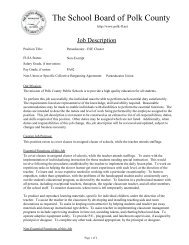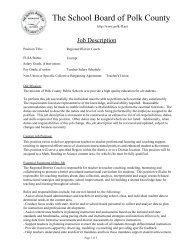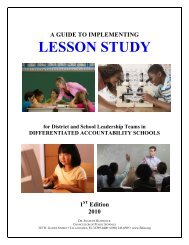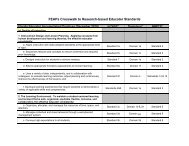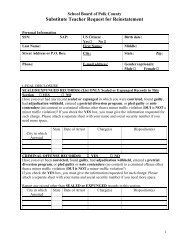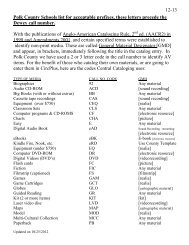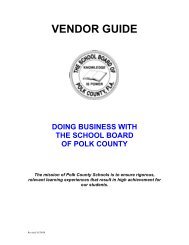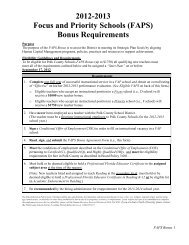SCHOOL IMPROVEMENT PLAN - Polk County School District
SCHOOL IMPROVEMENT PLAN - Polk County School District
SCHOOL IMPROVEMENT PLAN - Polk County School District
You also want an ePaper? Increase the reach of your titles
YUMPU automatically turns print PDFs into web optimized ePapers that Google loves.
Palmetto Elementary – 2008-2009<br />
<strong>SCHOOL</strong> <strong>IMPROVEMENT</strong> <strong>PLAN</strong><br />
<strong>District</strong>:<br />
Principal Name:<br />
SAC Chair:<br />
Superintendent:<br />
<strong>Polk</strong><br />
Luis P. Alvarez<br />
Kennith Estrada<br />
Dr. Gail McKinzie<br />
Date of <strong>School</strong> Board Approval:<br />
"The mission of <strong>Polk</strong> <strong>County</strong> Public <strong>School</strong>s is to ensure rigorous, relevant learning experiences that result in high<br />
achievement for our students."<br />
1
Palmetto Elementary – 2008-2009<br />
<strong>School</strong> at a Glance - 2008<br />
AYP: Yes No X Percentage 92%<br />
<strong>School</strong> Grade:<br />
A<br />
AYP Status: (Title I schools only)<br />
Not SINI<br />
PREVENTIVE (First 4 years of NOT making AYP)<br />
SINI-1 Consequence: Choice with Transfer, Supplemental Education Services<br />
Holding: Yes No<br />
Subject: Reading Math<br />
Category:<br />
SINI-2 Consequence: Choice with Transfer, Supplemental Education Services<br />
Holding: Yes No<br />
Subject: Reading Math<br />
Category:<br />
SINI-3 Consequence: Choice with Transfer, Supplemental Education Services,<br />
Corrective Action<br />
Holding: Yes No<br />
Subject: Reading Math<br />
Category:<br />
CORRECTIVE (Failed to achieve AYP for 5 or more years)<br />
SINI-4<br />
SINI-5<br />
Consequence: Choice with Transfer, Supplemental Education Services,<br />
Restructuring Planning<br />
Holding: Yes No<br />
Subject: Reading Math<br />
Category:<br />
Consequence: Choice with Transfer, Supplemental Education Services,<br />
Restructuring<br />
Holding: Yes No<br />
Subject: Reading Math<br />
Category:<br />
2
Palmetto Elementary – 2008-2009<br />
KEY:<br />
Holding = Maintain previous year’s SINI status and level of NCLB consequences<br />
SINI = <strong>School</strong>s In Need of Improvement<br />
Category = Level of action given based on SINI status, school grade, and AYP percentage<br />
• I = A’s, B’s, C’s and Ungraded <strong>School</strong>s with at least 80% AYP criteria met<br />
• II = <strong>School</strong>s with less than 80% AYP criteria met, and all D’s and F’s<br />
3
Palmetto Elementary – 2008-2009<br />
(This and the following pages are the location for your Three-Year data, both AYP and <strong>School</strong> Grades. You<br />
can get this information by going to:<br />
• Public Folders<br />
• Assessment, Accountability, Evaluation<br />
• SIP<br />
• Three-Year Data<br />
Select your school’s document and save it to your computer. Next, open the document and hit the “Ctrl” key<br />
and the “A” key to select everything in this document. Then, select “Ctrl” key and “C” to copy this<br />
information. Next, come to this page in the SIP and paste (“Ctrl” and “V”) the information here. After pasting,<br />
please space the information to create a nice looking document. AFTER PASTING, PLEASE DELETE<br />
THESE INSTRUCTIONS – THEY DO NOT SELF-DESTRUCT.<br />
4
Palmetto Elementary – 2008-2009<br />
<strong>SCHOOL</strong> <strong>IMPROVEMENT</strong> <strong>PLAN</strong><br />
Vision/Mission/Belief Statements<br />
Vision:<br />
The vision of our school is to provide opportunities for students to achieve both cooperatively and individually.<br />
We believe it is our responsibility to prepare all students to reach their highest potential and become productive<br />
citizens.<br />
Mission:<br />
The mission at Palmetto Elementary is to provide each student a diverse education in a safe and supportive<br />
environment that encourages self-discipline, motivation, and excellence in learning.<br />
Belief Statements:<br />
At Palmetto Elementary we believe that all students can and will learn. We believe that instruction should be<br />
differentiated to meet the needs of all students and that teachers and administration must be committed to<br />
providing our students with a quality education.<br />
5
Palmetto Elementary – 2008-2009<br />
6
Palmetto Elementary – 2008-2009<br />
<strong>SCHOOL</strong> <strong>IMPROVEMENT</strong> <strong>PLAN</strong><br />
<strong>School</strong> Profile/Demographics<br />
<strong>School</strong> Profile/Demographics:<br />
Palmetto Elementary opened in August 2007, serving grades K-5 and serving the community as a shelter. As a<br />
new school, several of the expected statistics have not yet been calculated.<br />
Our students are zoned to us from Poinciana. Feeder schools are Dundee Ridge and Haines City High <strong>School</strong>.<br />
Palmetto is a new school and includes 5 buildings with 48 classrooms and 644 students currently present. An<br />
Art and Music suite is located on-site, where we are building our chorus and searching for artists for Art Club.<br />
Palmetto Elementary, statewide, is a Title I school with 86% of our students receiving free and reduced lunch.<br />
The student population is 11.6% White, 24.6% African American, 57% Hispanic, .6% Asian, 1.1 Indian, and<br />
5.1 Multi-racial. Palmetto has a population of 90% minority.<br />
Testing Information<br />
2007-2008<br />
PALMETTO ELEMENTARY <strong>SCHOOL</strong> (1702) POLK, (53)<br />
315 PALMETTO ST, POINCIANA, FL 34759-4366<br />
<strong>School</strong> Phone: 863-427-6012, Principal: LUIS ALVAREZ<br />
SubjectState of Florida A+ Plan<br />
Federal No Child Left Behind Act<br />
<strong>School</strong> Grade<br />
A<br />
This grade is calculated by adding points earned from each of the performance areas below.<br />
92 % of criteria satisfied<br />
NO for AYP<br />
This percent is based on a total of 39 criteria that every school must meet, if applicable.<br />
Reading<br />
• 63% of students reading at or above grade level<br />
• 63% of students making a year's worth of progress in reading<br />
• 67% of struggling students making a year's worth of progress in reading<br />
BLACK, ENGLISH LANGUAGE LEARNERS students in this school need improvement in Reading.<br />
Math<br />
• 67% of students at or above grade level in math<br />
• 83% of students making a year's worth of progress in math<br />
• 79% of struggling students making a year's worth of progress in math<br />
ENGLISH LANGUAGE LEARNERS students in this school need improvement in Math.<br />
Writing<br />
• 76% of students are meeting state standards in writing.<br />
This school has met this criteria.<br />
7
Palmetto Elementary – 2008-2009<br />
Science<br />
• 32% of students at or above grade level in Science.<br />
**Title I refers to the federal law that provides funding for low-income students. A school is eligible for Title I<br />
status when at least 35% (targeted assistance) or 40% (school wide) of its students qualify for free or reducedprice<br />
lunch based on their families' income levels.<br />
<strong>School</strong> Efficiency Indicator for 2007-2008 relates money spent at the school-level with student performance at<br />
that school allowing users to evaluate the efficiency and effectiveness compared to other schools.<br />
Palmetto serves 3% of ESE including Pre-K(9x7, ESE), VE Self-Contained, Gifted, an Emotional Behaviorally<br />
Disturbed unit, and Speech and Language. Teacher/Class size ratio is an average of 18 to 1 in Kindergarten<br />
through 3rd grade and 22 to 1 in 4th and 5th grade, which makes an average of 18 to 1 in all grades. Our staff<br />
population is 47% White, 13% African American, 36% Hispanic, and 4% other.<br />
Unique Aspects: Acaletics, Technology, Well seasoned staff, Dual Language, Strings.<br />
Being a new school, we are working on community partners. We are currently communicating with Avatar,<br />
Publix, MidFlorida Credit Union, and Pollo Tropical.<br />
8
Palmetto Elementary – 2008-2009<br />
Quality Staff<br />
Highly Qualified Certified Administrators:<br />
List your school’s highly qualified administrators and briefly describe their credentials and experience<br />
with increasing student academic achievement.<br />
Principal<br />
Luis P. Alvarez, our principal, has 37 years experience in education, 20 of those years as an administrator. He<br />
has a Masters Degree in Administration and Supervision. Mr. Alvarez has taught in elementary, middle, and<br />
high school. His entire teaching and administrative career has been in low performing school. He knows the<br />
needs of all children, especially the bilingual children, having come to this country from Cuba at the age of 16.<br />
When addressing student achievement, Mr. Alvarez likes to think outside the box. He does this by:<br />
* Offering after school programs 5 days a week to those students who have tested at Level 1 and Level 2.<br />
* Inviting the lower level students to a summer camp emphasizing Reading, Writing, Math, and Science.<br />
* Having specialized software available on the computers located in the classroom and Computer Labs.<br />
* Hiring a consultant to help diagnose student decoding problems.<br />
* Analyzing test scores to provide the best possible placement for each child. (Example: Placing<br />
upcoming 3rd graders in classrooms with flexible scheduling and a low pupil/teacher ratio and providing a<br />
highly qualified paraprofessional to assist the classroom teacher.)<br />
* Vice-Chairman of Haines City Regional Chamber of Commerce.<br />
* Brought Alta Vista Elementary up from a “D” to a “C”, and then from a “C” to a “B”.<br />
* Professional development, Kagan, Acaletics, Larry Bell, and LFS.<br />
* Decisions are made on data research.<br />
* LFS Strategies in the K-12 plan.<br />
* Curriculum Maps<br />
Assistant Principal<br />
Jennifer Blackburn, Assistant Principal, has a Bachelor of Science in Elementary Education and a Masters<br />
Degree in Educational Leadership. Mrs. Blackburn has been a part of <strong>Polk</strong> <strong>County</strong> <strong>School</strong>s for 8 years;<br />
Teaching First Grade, Second Grade, and Teacher Trainer. As the Assistant Principal of Palmetto Elementary,<br />
Mrs. Blackburn addresses student success by:<br />
* Training teachers in Kagan Cooperative Learning<br />
* Providing strategies in the five major components of Reading using Differentiated Instruction: phonemic<br />
awareness, phonics, vocabulary, fluency, and comprehension.<br />
* Attends data analysis trainings to aid in the implementation of the Continuous Improvement Model.<br />
* Provides high yield strategies through Learning Focus Solutions to increase student achievement in<br />
Reading, Writing, Math, and Science.<br />
* Working with teachers to analyze data charts of low performing students.<br />
* Write From The Beginning Training<br />
* Summer <strong>School</strong> director for 2 years<br />
* SES Facilitator<br />
9
Palmetto Elementary – 2008-2009<br />
Recruitment/Retention of Highly Qualified Teachers:<br />
Describe strategies to recruit and retain high-quality, highly qualified teachers to high-need academic<br />
areas and schools.<br />
Strategies to recruit and retain high-quality teachers, is a goal for Palmetto. The school is working hard to build<br />
relationships with surrounding businesses. The administration is working towards building communication and<br />
team building within the faculty through:<br />
* Developing a hospitality committee<br />
* Collaboration among grade levels<br />
* Team building activities<br />
* What we do to retain teachers: Mentoring (National Board), Training, Free assistance for ESOL<br />
Certification.<br />
Staff List:<br />
NAME<br />
AREA OF<br />
CERTIFICATION<br />
TEACHING FIELD<br />
CERTIFICATE<br />
TYPE<br />
# YEARS<br />
TEACHING<br />
AMARIS AYALA HERNAIZ<br />
ELEMENTARY ED K-6,<br />
FOREIGN LANGUAGE K-<br />
1 Teacher, Fourth TEMPORARY 2<br />
DANIELLE L THOMPSON ELEMENTARY ED K-6 Teacher, Third TEMPORARY 2<br />
GYORGY HORVATH ELEMENTARY ED K-6 Teacher, First TEMPORARY 5<br />
IVELISSE PHILLIPS PREK- PRIMARY ED Teacher, Second TEMPORARY 1<br />
LADI APAKA DIGA ELEMENTARY ED K-6 Teacher, KG TEMPORARY 8<br />
LINDA M STEMMERMAN ELEMENTARY ED K-6 Teacher, Second PROFFESIONAL 2<br />
SAMANTHA CHARESE<br />
STULTZ ELEMENTARY ED K-6 Teacher, Third TEMPORARY 2<br />
SHARON A KANE<br />
PREK – PRIMARY ED,<br />
PREK HANDICAPPED,<br />
ESOL Teacher, PK PROFFESIONAL 4<br />
ANTONIA R ALLEN<br />
ELEMENTARY ED 1-6,<br />
ESOL<br />
ELEMENTARY ED 1-6,<br />
ESOL<br />
Teacher, Program<br />
Facilitator Title I PROFFESIONAL 28<br />
Teacher, Network<br />
Manager PROFFESIONAL 17<br />
BROOK DEE PEABODY<br />
CARMEN E APONTE-<br />
ROSA FOREIGN LANG, ESE Teacher, PK PROFFESIONAL 5<br />
CAROLYN JEANNE<br />
CRAFT<br />
CHARLOTTE DARLENE<br />
CLIFTON<br />
CHRISTINA A MATOS<br />
ELEMENTARY ED 1-6,<br />
ESOL<br />
Teacher, Instructional<br />
Coach PROFFESIONAL 28<br />
PRE K-PRIMARY ED,<br />
ESOL Teacher, Second PROFFESIONAL 7<br />
ELEMENTARY ED K-6,<br />
ESOL Teacher, KG PROFFESIONAL 1<br />
CRISALIE DUEY DELA<br />
CRUZ ELEMENTARY ED K-6 Teacher, Fourth PROFFESIONAL 10<br />
10
Palmetto Elementary – 2008-2009<br />
DONNA WALKER<br />
ELEMENTARY ED 1- 6,<br />
THOMPSON<br />
ESOL Teacher, Fourth PROFFESIONAL 28<br />
ELEMENTARY ED 1-6,<br />
FRANCINA LEWIS ESOL, GIFTED, MID 5-9 Teacher, Writing<br />
MAINER<br />
ENGLISH<br />
Resource Title I PROFFESIONAL 29<br />
HEATHER LYNN<br />
MONTEITH ELEMENTARY ED K-6 Teacher, First PROFFESIONAL 2<br />
HECTOR A MARRERO JR ART K-12 Teacher, Art E PROFFESIONAL 9<br />
JENNIFER DIANE<br />
ELEMENTARY ED 1-6,<br />
BLACKBURN<br />
ESOL Asst Prin Elem PROFFESIONAL 7<br />
JENNIFER JOY SMITH ELEMENTARY ED K-6 Teacher, Fourth PROFFESIONAL 12<br />
JILLIAN FRANCES GAY PRE K-PRIMARY ED Teacher, Third PROFFESIONAL 4<br />
ELEMENTARY ED 1-6,<br />
LILLY W DARITY<br />
ESOL,READING K -12 Teacher, Second PROFFESIONAL 28<br />
LINDA S WRAY ELEMENTARY 1-6, ESOL Teacher, Fifth PROFFESIONAL 38<br />
<strong>SCHOOL</strong><br />
PRINCIPAL,MATH 6-<br />
LUIS PABLO ALVAREZ 12,MARKETING 6-12, Principal-Elem PROFFESIONAL 36<br />
ELEMENTARY ED 1-6,<br />
LYNDA H WATERS ESOL Teacher, Fifth PROFFESIONAL 24<br />
MARIA MAGDALENA<br />
PEREZ<br />
MARY A COOK<br />
MILLIE ROMAY<br />
GARRISON CAMPBELL<br />
PAMELA MARIE MCCALL<br />
ROBERT C HOLMBERG<br />
FOREIGN LANG<br />
SPANISH K-1, Counselor E PROFFESIONAL 8<br />
ELEMENTARY ED 1-6,<br />
ESOL Teacher, Fourth PROFFESIONAL 9<br />
ELEMENTARY ED 1-6,<br />
ESOL Teacher, First PROFFESIONAL 24<br />
MEDIA SPECIALIST,<br />
ELEMENTARY ED 1-6,<br />
ESOL Lib/Med Spec-E PROFFESIONAL 24<br />
ELEMENTARY ED 1-6,<br />
ESOL Teacher, Fifth PROFFESIONAL 7<br />
ELEMENTARY ED K-6,<br />
GUIDANCE &<br />
COUNSELING PRE K -12 Teacher, Third PROFFESIONAL 4<br />
SARAH BETH SHIFLEY<br />
SARAH M DODSON ELEMENTARY K-6 Teacher, Second PROFFESIONAL 4<br />
SMRUTI SHAH SAKATOS MUSIC K- 12 Teacher, Music E PROFFESIONAL 4<br />
EMMANUEL RODRIGUEZ<br />
RAMOS PHYSICAL ED K- 12 Teacher, PE E TEMPORARY 6<br />
JORGE LARZABAL CRUZ ELEMENTARY ED K-6 Teacher, Fourth TEMPORARY 20<br />
MARIA MORENO<br />
PRE K - PRIMARY ED,<br />
FOREIGN LANG<br />
SPANISH K-1 Teacher, KG TEMPORARY 3<br />
MARINA GOMEZ PULIDO ELEMENTARY ED K-6 Teacher, Third TEMPORARY 2<br />
MICHAEL J BASTEDO<br />
ELEMENTARY ED K-6,<br />
ESOL Teacher, Fifth TEMPORARY 2<br />
ROSA IDALY BRADLEY<br />
ELEMENTARY ED K-6,<br />
PRE K Teacher, Third TEMPORARY 2<br />
TAMARA KAY PERRY<br />
ELEMENTARY ED K-6,<br />
MID 5-9 ENGLISH Teacher, Second TEMPORARY 2<br />
LAURA BETH WILLOWBY<br />
ELEMENTARY ED K-6,<br />
ESE Teacher, VE PROFFESIONAL 1<br />
11
ALMA GONZALEZ<br />
JANICE BRIDGES<br />
ROBYNN HAMRICK<br />
Palmetto Elementary – 2008-2009<br />
ELEMENTARY ED K-6,<br />
ESE, ESOL Teacher, VE PROFFESIONAL 1<br />
ELEMENTARY ED K-6,<br />
ESOL Teacher, First PROFESSIONAL 38<br />
ELEMENTARY ED K-6,<br />
ESOL Teacher, KG PROFFESIONAL 5<br />
ANNATJIE DAILEY PRE K-PRIMARY ED Teacher, First TEMPORARY 3<br />
PRE K-PRIMARY ED,<br />
TERESA SHAW<br />
ESE Teacher, VE TEMPORARY 2<br />
12
Palmetto Elementary – 2008-2009<br />
<strong>SCHOOL</strong> <strong>IMPROVEMENT</strong> <strong>PLAN</strong><br />
Additional Requirements<br />
Coordination and Integration<br />
Please describe how federal, state, and local services and programs will be coordinated and integrated in<br />
the school. Please include other Title programs, as well as violence prevention programs, nutrition<br />
programs, housing programs, Head Start, adult education, vocational and technical education, and/or job<br />
training, as applicable.<br />
<strong>School</strong>wide Improvement Model<br />
Describe the evidence-based <strong>School</strong> Improvement Model at your school. How is this model being<br />
implemented, and how has it helped with student achievement*<br />
Palmetto Elementary uses an eight step process for their school continuous improvement plan (CIM). The<br />
professional development to incorporate this 8 step process was provided in the summer to administration and<br />
leadership team by Title One. Administration and leadership team will provide professional development to all<br />
staff throughout the year by grade level and faculty meetings. Administration and Leadership team will be<br />
responsible for monitoring progress. Professional development will be: reviewing outline of the CIM model,<br />
establishing an outline, overview of instructional focus all throughout the year, data analysis with use of<br />
frequent assessment, progress monitoring, and maintenance of the CIM plan will begin in August and continue<br />
throughout the year.<br />
This model begins with disaggregating test data for our school which is based on the Florida Continuous<br />
Improvement Model. The main data source is the FCAT SSS assessment. Data analyzed includes percent of<br />
students scoring Level 2 or below, Level 3 or above, percent of students in grades 3, 4, and 5 who made<br />
learning gains, percent of students in the lowest 25% who made progress and percent of participation. This<br />
analysis is carried through all the subgroups for our school.<br />
Step 2 – In this process is to set up the instructional time line. Instructional priorities are set according to the<br />
greatest gaps in performance and a plan is made as related to the number of instructional days we have<br />
available. Goals are set for each grade level, as well as the subgroups within each grade. This timeline is set<br />
within the <strong>Polk</strong> <strong>County</strong> Curriculum Maps (PCCM).<br />
Step 3 – Moves into identifying the Instructional Focus. As teachers analyze the data from their students, they<br />
will identify the Sunshine State Standards that their students have not mastered. These assessed benchmarks are<br />
identified district wide using the PCCM.<br />
Step 4 – Frequent Assessments are the focus for step 4. Diagnostic, screening, progress monitoring, and<br />
outcome measures will be used to identify areas of strengths and weaknesses. Students who need remediation<br />
and/or immediate intensive intervention in the areas of reading, writing, or math will have an Academic Success<br />
Plan (ASP). Quarterly benchmark assessments will be ongoing throughout the school year.<br />
13
Palmetto Elementary – 2008-2009<br />
Step 5 – Students who do not show mastery will receive tutorial services. This is step 5 of our process. Tutorial<br />
services will be provided during school and after school.<br />
Step 6 – Enrichment strategies are explored in step 6. Students will use FCAT Explorer, Odyssey lab and an<br />
additional 45min. for iii. Based on data level 1 students will be provided 20 minutes of intensive intermediate<br />
intervention daily.<br />
Step 7 – Is the Maintenance of our plan. We will develop and implement a plan for instruction, assessment, and<br />
maintenance in the benchmarks of our lowest achieving students. An instructional calendar based on the<br />
Continuous Improvement Model (CIM) will be adapted in order to delineate instruction, assessment and<br />
maintenance teaching using the standards.<br />
Step 8 – The final step in the process is crucial. Step 8 is to Monitor Progress. Students will be given benchmark<br />
assessments at regular intervals (4 times a year) to determine progress. If progress is not being made, diagnostic<br />
tools will be used to determine areas needing further remediation. This model has helped student achievement<br />
by making teachers more aware of the whole group and individual needs and making a specific timeline for<br />
mastering each skill.<br />
This 8 step process assists student achievement by establishing an instructional yearly timeline, data analysis,<br />
high yield strategies, and progress monitoring tools which have increased student achievement by 3%.<br />
NCLB Public <strong>School</strong> Choice<br />
Describe the process used to provide parents with written notification on the academic progress of their<br />
child's school in a format and language parents can easily understand.<br />
All communications will be sent home weekly in a Wednesday Communication folder in English and Spanish.<br />
Communications are sent home explaining all state and district mandates.<br />
In addition to state and district mandates, a school newsletter is sent home monthly explaining upcoming school<br />
activities, awareness of grade level instruction, and important events. Teachers also send home class<br />
newsletters, agenda reports, and notes home to keep the lines of communication open between home and<br />
school. Our Title One Instructional Support Teacher (IST) and Family Involvement Para work with each grade<br />
level to support effective communication between teacher and parent.<br />
The following letter is also provided in Spanish:<br />
Public <strong>School</strong> Choice Notice to Parents<br />
Please attach a copy of the Public <strong>School</strong> Choice Notice to Parents in MS Word.doc format only.<br />
Notification of SINI Status<br />
Please attach a copy of the Notification of SINI Status to Parents in MS Word.doc format only.<br />
14
Palmetto Elementary – 2008-2009<br />
Preschool Transition (elementary schools only)<br />
Describe the plans for assisting preschool children in transition from early childhood programs to local<br />
elementary school programs as applicable.<br />
Palmetto hosts 2 pre-school sites with one 9x7 Self-Contained and one ESE inclusion. Pre-K students are<br />
continuously progress monitored and work within each one of the Individual Educational Plans (IEP). All<br />
Preschool teachers complete a data analysis sheet, on each student, to administration to describe specific skills<br />
and knowledge as well as the ability to form meaningful relationships. Those with low readiness receive<br />
intensive intervention with Speech and Language program, plus assistance from local programs, such as Head<br />
Start. In April, Pre-K parents are encouraged to attend a Kindergarten Round-Up. There, parents with their<br />
children are able to tour Kindergarten classrooms and meet teachers. Pre-K parents are also given an orientation<br />
to assist in the transition by going over state mandates, district expectations, and Sunshine State Standards.<br />
Within the first 20 days of Kindergarten, students receive FLKRS, IDEL, DIBELS, and On-Going Assessments<br />
to measure academic and physical capabilities. After receiving data Pre-K and Kindergarten teachers meet to<br />
discuss strengths and weaknesses of the curriculum. These results assist Pre-K teachers in a needs assessment of<br />
last year’s outcomes. It also gives Kindergarten teachers a foundation of the student’s academic knowledge. The<br />
teachers will send home a weekly newsletter to be placed in the Wednesday Folder. Funding is provided by<br />
<strong>District</strong> and State Funds.<br />
Teacher Mentoring<br />
Describe your school’s Teacher Mentoring Program.<br />
Our teacher mentoring program involves everyone. Palmetto strives to retain our highly qualified teachers by<br />
providing peer teachers and orientation programs to support all new teachers. The instructional coach, Carolyn<br />
Craft, is responsible for mentoring all beginning teachers. Mentoring is provided, by the instructional coach,<br />
through modeling, classroom observation, and professional development. Additionally, provided are weekly<br />
and monthly workshops to keep our teachers abreast of the newest and most productive research-based<br />
techniques. Beginning teachers are also provided assistance within their grade level. Each team leader assists<br />
any new member with lesson plans, school functions, and grade level needs. Jennifer Blackburn, the assistant<br />
principal, is also responsible for monitoring the beginning teachers through observations and evaluations.<br />
Low performing teachers are identified by weekly walk-throughs, summative and formative observations. The<br />
instructional coach and/or mentors are provided for any struggling teacher. Evaluations are done by the<br />
administrative team through summative and formative observations. Also Flight 2 and 3 trainings are checked<br />
to ensure eligibility of mentor. Mentors meet weekly or as needed to develop effective teaching strategies,<br />
classroom management, and evaluation and feedback on instruction.<br />
As a result, high-quality teachers are present and teacher turnover is low. Assigning mentors also produces high<br />
quality instruction thus producing high academic performance by students.<br />
Mentors and Mentees will be identified as needed. Schedule of mentoring activities will depend on the needs of<br />
the teachers.<br />
15
Palmetto Elementary – 2008-2009<br />
Teacher Mentoring List<br />
TEACHER MENTORING LIST<br />
<strong>School</strong> Name:<br />
Palmetto Elementary<br />
<strong>District</strong>: <strong>Polk</strong><br />
Mentor Name<br />
Proven Student<br />
Achievement<br />
Mentee Assigned Planned Mentoring<br />
Activities<br />
Carolyn Craft Reading Coach Anita Olah Observing,modeling,PD<br />
Carolyn Craft Reading Coach Tina Dailey Observing,modeling,PD<br />
Extended Learning Opportunities<br />
Describe the programs that are provided before and after-school, during the summer, and during the<br />
extended school year.<br />
Unfortunately, we do not meet the requirements for the Supplemental Educational Services. However, our<br />
dedicated teachers here at Palmetto Elementary have volunteered their time to tutoring and FCAT preparation.<br />
Students are identified based on FCAT, SAT 10, DIBELS, and other diagnostic test scores along with AYP<br />
subgroup needs (African American, Hispanic, Economically Disadvantage, Limited English Proficiency).<br />
Soliloquy<br />
Odyssey<br />
FCAT Explorer<br />
All level 1 and 2 students, targeted ELL and ESE students will be closely monitored and results from the after<br />
FCAT prep will be shared with classroom teachers to target areas of concern and provide alternative strategies<br />
to increase student performance.<br />
Also, the Media Center has extended the hours before and after school. <strong>School</strong> book club meets twice a month.<br />
16
Palmetto Elementary – 2008-2009<br />
<strong>SCHOOL</strong> <strong>IMPROVEMENT</strong> <strong>PLAN</strong><br />
Reading<br />
Needs Assessment:<br />
Did all student subgroups meet AYP targets*<br />
Did 50% or more of lower 25% make learning gains*<br />
Did 50% or more make learning gains*<br />
Did the percent proficient increase*<br />
2007-2008<br />
<strong>School</strong> Grade<br />
A<br />
This grade is calculated by adding points earned from each of the performance areas below.<br />
92 % of criteria satisfied<br />
NO<br />
This percent is based on a total of 39 criteria that every school must meet, if applicable.<br />
Reading<br />
• 63% of students reading at or above grade level<br />
• 63% of students making a year's worth of progress in reading<br />
• 67% of struggling students making a year's worth of progress in reading<br />
BLACK, ENGLISH LANGUAGE LEARNERS students in this school need improvement in Reading.<br />
Math<br />
• 67% of students at or above grade level in math<br />
• 83% of students making a year's worth of progress in math<br />
• 79% of struggling students making a year's worth of progress in math<br />
ENGLISH LANGUAGE LEARNERS students in this school need improvement in Math.<br />
Writing<br />
• 76% of students are meeting state standards in writing.<br />
This school has met this criteria.<br />
Science<br />
• 32% of students at or above grade level in Science.<br />
**Title I refers to the federal law that provides funding for low-income students. A school is eligible for Title I<br />
status when at least 35% (targeted assistance) or 40% (school wide) of its students qualify for free or reducedprice<br />
lunch based on their families' income levels.<br />
<strong>School</strong> Efficiency Indicator for 2007-2008 relates money spent at the school-level with student performance at<br />
that school allowing users to evaluate the efficiency and effectiveness compared to other schools.<br />
No ROI Data<br />
Student achievement data and professional development information, coupled with FCAT scores, school grade<br />
and AYP information comprise the information that leadership and the SAC used to modify this year’s reading<br />
objectives.<br />
17
Palmetto Elementary – 2008-2009<br />
Objective:<br />
By Spring of 2009, 80 % of 1st grade students will have 80% learning gains.<br />
Grade 2-Sat10-80% Learning Gains<br />
Grade 3-FCAT 80% at Level 2 or higher<br />
Grade 4-Kaplan 80% at 80% or higher<br />
Grade 5- Kaplan 80% at 80% or higher<br />
By May 2009, 65% of all students in Grades 3-5 will demonstrate annual<br />
learning gains in FCAT Reading.<br />
Strategies:<br />
The reading block will be increased to 120 minutes per day for students in the lowest quartile. Soliloquy<br />
will be used for fluency for grades 2 and 3. All teachers will build and use word walls to improve<br />
vocabulary skills. Read-a-louds will continue within the Trophies basal. All students will continue to<br />
receive instruction using the Odyssey ILS program. Palmetto will also implement strategies in the<br />
district’s K12 Reading Plan to include the Learning Focused Strategies for all students. Iii students<br />
reading time will be increased by 20 minutes daily. In addition to the daily 90 minutes, an additional 10<br />
minutes will be provided by the classroom teacher providing immediate intensive intervention to the<br />
student’s specific needs as determined by a diagnostic assessment. Each classroom will maintain a<br />
carefully assembled classroom library. Reading stations are set up throughout the room in various areas<br />
to reinforce and extend learning without the assistance of the teacher. Students practice reading, writing,<br />
speaking, listening, and working with letters and words. SRA (Grade 2), Kaplan Spell Read (Grades 3,<br />
4,5 including iii). All teachers will use Thinking Maps graphic organizers and able to create their own<br />
through Inspiration. Teachers will also be given one day a month for LFS Unit Planning.<br />
:<br />
Evaluation:<br />
DIBELS, Odyssey, STAR Reading, Harcourt and IDEL. With Kaplan, 1 week after the tests have been<br />
scanned, teachers will have the data documented and will disaggregate with administration.<br />
Evidence-Based Program:<br />
Harcourt Trophies, Reading Intervention, Readers Theater, Soliloquy, Odyssey, Accelerated Reader,<br />
Thinking Maps, Study Island, Kaplan Spell Read<br />
18
Palmetto Elementary – 2008-2009<br />
Professional Development Aligned with this Objective:<br />
The staff was trained in LFS Days 3 and 4, PBS, Bullying, throughout the year Barbara Block will be coming<br />
once a month to work on Classroom Management, with our grant that we were awarded through Boys of Color<br />
teachers will become more aware of the needs of minority students and work with their parents on how to help<br />
their children become more successful. Odyssey Implementation and data training K-5, Soliloquy training,<br />
ESOL Strategies Training.<br />
The Instructional Coach and Curriculum support will provide training in the following areas:<br />
Professional development<br />
Planning<br />
Modeling lessons<br />
Coaching<br />
Coach-teacher conferences<br />
Student assessment<br />
Data reporting<br />
Data analysis<br />
Meetings<br />
Knowledge building<br />
Other (coach will specify activities)<br />
In addition, school administrators and instructional coach will work together to schedule and plan professional<br />
development based on Scientifically-Based Reading Research (SBRR) and/or study groups designed to increase<br />
teachers’ knowledge of SBRR. Coaches will deliver reading/learning strategies to the entire instructional staff<br />
during professional development days.<br />
At the elementary level, administrators will provide opportunities for the reading coach to assist classroom<br />
teachers during common planning times. Since most common planning times at the elementary level consist of<br />
Learning Team meetings, the instructional coach will be present, as much as possible to share best practices and<br />
instructional strategies related to the focus and results of each Learning Team meeting analysis.<br />
Budget:<br />
Evidence-Based Program(s)/Material(s)<br />
Description of Resources Funding Sources Available<br />
Amount<br />
Technology<br />
Description of Resources Funding Sources Available<br />
Amount<br />
AR and STAR Reading 09 Lottery 1,083.00<br />
19
Palmetto Elementary – 2008-2009<br />
Professional Development<br />
Description of Resources Funding Sources Available<br />
Amount<br />
LFS Training Day 3 and 4 and materials Title One 5,100.00<br />
People, Other<br />
Description of Resources Funding Sources Available<br />
Amount<br />
Non-Highly Qualified Certified Out-of-Field Instructors<br />
List instructors, paraprofessionals, and/or teachers who are teaching out-of-field that are NOT highly<br />
qualified. Describe the support and professional development being planned and provided for these<br />
professionals.<br />
20
Palmetto Elementary – 2008-2009<br />
<strong>SCHOOL</strong> <strong>IMPROVEMENT</strong> <strong>PLAN</strong><br />
Math<br />
Needs Assessment:<br />
Did all student subgroups meet AYP targets*<br />
Did 50% or more of lower 25% make learning gains*<br />
Did 50% or more make learning gains*<br />
Did the percent proficient increase*<br />
In June 2008, 67% of the students in Grades 3-5 scored level 3 or above on the FCAT Mathematics Assessment.<br />
Objective:<br />
By Spring of 2009, 77 % of Grade 3-5 students will be at Achievement Level 3<br />
or above in Math as evidenced by the FCAT .<br />
Strategies: List strategies that…<br />
Apply to all students:<br />
Relate to differential instruction:<br />
Provide immediate interventions for students you have identified as struggling:<br />
Explain how you will schedule and conduct formalized inter- and intra-school meetings and discussions:<br />
All teachers will implement Everyday Counts daily in grades K-5.<br />
Teachers will use Daily Bites, and use Quick Picks each day to reinforce previously<br />
taught skills.<br />
Math centers will provide differentiated instruction based on student assessments.<br />
The math block will be 60 minutes daily with an additional 20 minutes for students in the<br />
lowest quartile.<br />
Teachers will be implementing our new Sunshine State Standards.<br />
21
Palmetto Elementary – 2008-2009<br />
Teachers will use higher order thinking skills, questioning techniques during instruction<br />
for all students and writing for summarization.<br />
All students will continue to receive instruction using the Odyssey ILS program.<br />
Students will be assessed with Kaplan.<br />
The LFS facilitator will provide professional development and model lessons for effective<br />
instruction.<br />
Larry Bell strategies and 12 Powerful Words<br />
Evaluation:<br />
Kaplan Assessment<br />
Evidence-Based Program:<br />
Larry Bell strategies and 12 Powerful Words<br />
Acaletics, Odyssey, Everyday Counts, Daily Bites<br />
Professional Development Aligned with this Objective:<br />
The staff will be trained on the implementation for Everyday Counts, Odyssey, Thinking<br />
Maps & Daily Bites.<br />
Budget:<br />
Evidence-Based Program(s)/Material(s)<br />
Description of Resources Funding Sources Available<br />
Amount<br />
Technology<br />
Description of Resources Funding Sources Available<br />
Amount<br />
22
Palmetto Elementary – 2008-2009<br />
Professional Development<br />
Description of Resources Funding Sources Available<br />
Amount<br />
People, Other<br />
Description of Resources Funding Sources Available<br />
Amount<br />
Non-Highly Qualified Certified Out-of-Field Instructors<br />
List instructors, paraprofessionals, and/or teachers who are teaching out-of-field who are NOT highly<br />
qualified. Describe the support and professional development being planned and provided for these<br />
professionals.<br />
23
Palmetto Elementary – 2008-2009<br />
<strong>SCHOOL</strong> <strong>IMPROVEMENT</strong> <strong>PLAN</strong><br />
Writing<br />
Needs Assessment:<br />
Did the percent proficient increase*<br />
In 2008, 76% of students met the standards in writing by scoring 3.0 or above on the FCAT Writing<br />
Assessment.<br />
Objective:<br />
By Spring, of 2009, 80 % of 4 th Grade students will be at an Essay score of 3.0 or above on FCAT<br />
Writing to enable Palmetto to meet AYP goals through safe harbor.<br />
Strategies: List strategies that…<br />
Apply to all students:<br />
Relate to differential instruction:<br />
Provide immediate interventions for students you have identified as struggling:<br />
Explain how you will schedule and conduct formalized inter- and intra-school meetings and discussions:<br />
Teachers will receive staff development ongoing via school level resource writing<br />
teacher.<br />
Training will be in the areas of the writing process plan for instruction of individual traits<br />
within content area instruction.<br />
Teachers will integrate technology, use computers to publish writing pieces, use the<br />
Internet to research appropriate information for reports.<br />
All 4th grade students will participate in school wide writing prompts that will take place<br />
in the cafeteria, the first Tuesday of each month. Feedback will be given back to each<br />
student within 72 hours.<br />
Evaluation:<br />
FCAT rubric use for evaluation aligned to Florida Writes.<br />
24
Palmetto Elementary – 2008-2009<br />
Monitoring will be done through monthly writing prompts which will be administered<br />
school wide.<br />
QBA writing prompts will be used 3 times a year.<br />
Evidence-Based Program:<br />
Kathy Robinson, Melissa Forney, Thinking Maps, Word Wall<br />
Professional Development Aligned with this Objective:<br />
FCAT Prep Workshop for Florida Writes grades 3-5. Professional development in<br />
scaffolding writing process K-5.<br />
Budget:<br />
Evidence-Based Program(s)/Material(s)<br />
Description of Resources Funding Sources Available<br />
Amount<br />
Technology<br />
Description of Resources Funding Sources Available<br />
Amount<br />
Professional Development<br />
Description of Resources Funding Sources Available<br />
Amount<br />
People, Other<br />
25
Palmetto Elementary – 2008-2009<br />
Description of Resources Funding Sources Available<br />
Amount<br />
26
Palmetto Elementary – 2008-2009<br />
<strong>SCHOOL</strong> <strong>IMPROVEMENT</strong> <strong>PLAN</strong><br />
Science<br />
Needs Assessment:<br />
For June 2008, 32% of our students scored level 3 or above on Science FCAT Assessment Test. This year we<br />
would like at least 40% of our students scoring level 3 or higher.<br />
Objective:<br />
By Spring of 2009, 40 % of 5th grade students will be at Achievement Level three or above in<br />
Science as evidenced by the <strong>School</strong> Grade report.<br />
Strategies: List strategies that…<br />
Apply to all students:<br />
Relate to differential instruction:<br />
Provide immediate interventions for students you have identified as struggling:<br />
Explain how you will schedule and conduct formalized inter- and intra-school meetings and discussions:<br />
Prepare and follow <strong>District</strong> Curriculum Maps calendar of when objectives will be taught in<br />
grades 1-5.<br />
Provide a Science teacher to teach the Science content area in 4th and 5th grades.<br />
Students will be instructed using the Harcourt Science Text Book Series grades 1-5.<br />
Manipulative and Science-saurus will be used to assist in teaching the benchmarks in<br />
grades 1-5.<br />
Science centers will be implemented in 5th grade.<br />
Students will use technology programs including but not limited to computer labs, FCAT<br />
Explorer, Study Island, resources, presentation software and multimedia tools to<br />
enhance instruction and provide guided practice and applications of the skills in Science.<br />
Use Harcourt Level Science Readers during Reading; 1 day a week or every other week.<br />
27
Palmetto Elementary – 2008-2009<br />
Evaluation:<br />
Monitor 5th Grade Science Standard using Kaplan.<br />
Monitoring will be done using pre and post tests for grades 4 and 5 (developed by the<br />
district) tied to SSS benchmarks, and performance tasks specifications for grade 5 along<br />
with basal unit, chapter tests, and FCAT Explorer Science.<br />
Evidence-Based Program:<br />
Harcourt Science Textbook Series<br />
Kaplan<br />
Odyssey<br />
FCAT Explorer Science<br />
Study Island<br />
Professional Development Aligned with this Objective:<br />
Ongoing workshops covering content, hands on activities, and FCAT Prep.<br />
Budget:<br />
Evidence-Based Program(s)/Material(s)<br />
Description of Resources Funding Sources Available<br />
Amount<br />
Technology<br />
Description of Resources Funding Sources Available<br />
Amount<br />
Study Island Subscription 09 Lottery 965.00<br />
Professional Development<br />
Description of Resources Funding Sources Available<br />
28
Palmetto Elementary – 2008-2009<br />
Amount<br />
People, Other<br />
Description of Resources Funding Sources Available<br />
Amount<br />
-Highly Qualified Certified Out-of-Field Instructors<br />
List instructors, paraprofessionals, and/or teachers who are teaching out-of-field who are NOT highly<br />
qualified. Describe the support and professional development being planned and provided for these<br />
professionals.<br />
29
Palmetto Elementary – 2008-2009<br />
<strong>SCHOOL</strong> <strong>IMPROVEMENT</strong> <strong>PLAN</strong><br />
Parental Involvement<br />
Goal:<br />
Parental/Family Involvement Programs<br />
Needs Assessment: 75% of parents will attend meetings and conferences during the 2008-2009 school year.<br />
Objective: By May 2009, 75% of parents will participate in decisions regarding their children’s educational documentation<br />
as evidenced by attendance at parent trainings, meetings or conferences.<br />
Strategies:<br />
A school parental involvement policy will be developed by all stakeholders, at Palmetto Elementary <strong>School</strong><br />
which will include a school family compact that will be distributed to parents with the back to school<br />
information packet. (signed compacts returned will be kept on file at the school)<br />
Palmetto Elementary <strong>School</strong> parents, community members and business partners will be involved in the<br />
development and evaluation of the <strong>School</strong> Improvement Plan.<br />
Palmetto Elementary <strong>School</strong> parents will be involved in decisions about how Title I funds are to be allocated<br />
and documentation retained to support this requirement.<br />
An annual public meeting will be held in the Lunchroom (AM & PM) to inform all stakeholders included staff,<br />
parents, business partners, and community members of the Palmetto’s participation in the Title I school wide<br />
program. Child care will be provided.<br />
Individual student’s assessment results, including an interpretation of those results will be provided to all<br />
parents.<br />
A plan will be developed to assist and to support the transition of pre-school students/families from early<br />
childhood programs to kindergarten.<br />
FCAT Workshops will be scheduled each month in the areas of Reading, Writing, and Mathematics.<br />
Parents will have the opportunity to access the Media Center and Computer Lab twice a month to assist their<br />
children.<br />
We include parents in the review and the writing of the parental involvement plan.<br />
Evaluation:<br />
The annual Title I survey will be conducted toward the end of the school year.<br />
Parent sign-in sheet.<br />
Evidence-Based Program:<br />
Parent Teacher Organization<br />
<strong>School</strong>, Family, and Community Partnerships<br />
Professional Development Aligned with this Objective:<br />
Parent grade nights with parental strategies in Math, Science, Reading, and Writing – Related Curriculum.<br />
30
Palmetto Elementary – 2008-2009<br />
Budget:<br />
Evidence-Based Program(s)/Material(s)<br />
Description of Resources Funding Sources Available<br />
Amount<br />
Technology<br />
Description of Resources Funding Sources Available<br />
Amount<br />
Professional Development<br />
Description of Resources Funding Sources Available<br />
Amount<br />
People, Other<br />
Description of Resources Funding Sources Available<br />
Amount<br />
31
Palmetto Elementary – 2008-2009<br />
<strong>SCHOOL</strong> <strong>IMPROVEMENT</strong> <strong>PLAN</strong><br />
Return on Investment<br />
Goal:<br />
Return on Investment<br />
Needs Assessment:<br />
Compared to similar schools, Palmetto’s percentile ranking is 30 and the percent of the highest ROI is 51.<br />
(DOE has not updated website) Palmetto Elementary ROI percentile ranking will increase by at least one percentile point.<br />
Objective:<br />
Strategies:<br />
Evaluation:<br />
Description of Resources Funding Source Available<br />
Amount<br />
Technology<br />
Description of Resources Funding Source Available<br />
Amount<br />
Professional Development<br />
Description of Resources Funding Source Available<br />
Amount<br />
32
Palmetto Elementary – 2008-2009<br />
People, Other<br />
Description of Resources Funding Source Available<br />
Amount<br />
Non-Highly Qualified Certified Out-of-Field Instructors<br />
List instructors, paraprofessionals, and/or teachers who are teaching out-of-field who are NOT highly<br />
qualified. Describe the support and professional development being planned and provided for these<br />
professionals.<br />
33
Palmetto Elementary – 2008-2009<br />
<strong>SCHOOL</strong> <strong>IMPROVEMENT</strong> <strong>PLAN</strong><br />
<strong>SCHOOL</strong> <strong>IMPROVEMENT</strong> <strong>PLAN</strong><br />
SAC Members<br />
Yes No The majority of the SAC members are not employed by the school district. The SAC is<br />
composed of the principal and an appropriately balanced number of teachers, education support<br />
employees, students (for middle and high school only), parents, and other business and community<br />
citizens who are representative of the ethnic, racial, and economic community served by the school*<br />
Measures Being Taken to Comply with SAC Requirement (complete only if your school is out of<br />
compliance).<br />
Member’s Name Position Signature<br />
1) Luis Alvarez Principal<br />
2) Jennifer Blackburn Assistant Principal<br />
3) Antonia Allen Title One<br />
4) Amaris Ayala Teacher<br />
5) Lilly Darity Teacher<br />
6) Marina Moreno Teacher<br />
7) Kennith Estrada Community Member<br />
8) Maribel Gill Community Member<br />
9) Damon Jones Parent<br />
10) Kevin Lewis Parent<br />
11) Tomas Ramos-Ayala Parent<br />
12)Rada Sosa<br />
Parent____________<br />
13) Mari Cruz Parent_____________<br />
14) Anibal Sosa Parent_<br />
15) D’Andre Williams Parent_<br />
34
Palmetto Elementary – 2008-2009<br />
<strong>School</strong> Advisory Council<br />
Describe the activities of the <strong>School</strong> Advisory Council.<br />
Palmetto <strong>School</strong> Advisory Council assists in the preparation, implementation, and evaluation of the <strong>School</strong><br />
Improvement Plan. The Council makes recommendations and assists the school administration in all areas of<br />
school improvement. These functions are performed through participatory decision-making by parents,<br />
educators, school staff, business people, and other community members who are stakeholders in the school. The<br />
<strong>School</strong> Advisory Council is in effect for the duration of each school year. At least 51% of the <strong>School</strong> Advisory<br />
Council membership will be composed of parents and community members. Other <strong>School</strong> Advisory Council<br />
members will include administrators, teachers, and education support staff. Members other than administrators<br />
of Palmetto <strong>School</strong> Advisory Council are elected by parents, community members, and education support staff.<br />
In the event that the elections do not constitute a membership that is balanced by ethnicity, race, or<br />
socioeconomic status of the student population, the principal may appoint members.<br />
Community members are appointed by the principal with input from the <strong>School</strong> Advisory Council membership.<br />
All new members joining the Council will receive training prior to or during the first meeting in September.<br />
Any member who accumulates 2 consecutive unexplained absences from noticed meetings will be replaced by<br />
the principal with <strong>School</strong> Advisory Council approval. Meeting times and locations will be agreed upon by all<br />
members of the <strong>School</strong> Advisory Council approval. Each meeting shall be held in the cafeteria at 8:15 a.m.<br />
Each year the time, date, and place of any meeting may be modified based upon the consensus vote of the<br />
members present at any meeting. Notice of each meeting will be given 2 weeks prior to each scheduled meeting<br />
by email, mail, phone call. The notice will include any votes that will be presented for a vote to the<br />
membership. The operation of the <strong>School</strong> Advisory Council is governed by Florida Statute 229.58 the policies<br />
of the <strong>Polk</strong> <strong>County</strong> <strong>School</strong> <strong>District</strong> and the Government in the Sunshine Law. Decisions made by the <strong>School</strong><br />
Advisory Council must be made within the boundaries of <strong>Polk</strong> <strong>County</strong> <strong>School</strong> Board policy. <strong>School</strong> Board<br />
members may review <strong>School</strong> Advisory Council By-Laws. <strong>School</strong> Board members approve <strong>School</strong> Advisory<br />
Membership and the <strong>School</strong> Improvement Plan.<br />
The <strong>School</strong> Advisory Council at Palmetto Elementary functions using all perimeters above and assures the<br />
continuous progress of Florida’s eight education goals in the school. The SAC operates within the policies of<br />
the <strong>School</strong> Board and the parameters established by the state legislature. Our school advisory council is<br />
composed of teachers, parents, the administrators, support staff, business and community representatives that<br />
reflect the ethnic, racial, and socio-economic background of our community. They also participate in the<br />
decision-making process regarding school improvement at the school level. The SAC also helps to develop and<br />
monitor the activities and progress of the <strong>School</strong> Improvement Plan (SIP) as well as the school’s annual budget.<br />
This includes but not limited to lottery allocations and school recognition funds. The SAC assists in the<br />
development of the budget and SIP plan by meeting and reviewing data. After reviewing data recommendations<br />
are given to assist in the area of student achievement and progress.<br />
Student performance data from DIBELS, Quarterly Benchmark Measures, and Kaplan for grades 3-5 will be<br />
used 3 times a year to progress monitor and identify all students K-5 who are at above average, low risk,<br />
moderate risk, or high risk of not meeting Grade Level Standards as established by the State of Florida. Further<br />
progress monitoring will be done by state-approved diagnostic assessment tools such as Fox in a Box, DAR,<br />
ERDA, and/or Bear Spelling. These target specific deficiencies so remediation can begin with student<br />
weaknesses. Harcourt Trophies intervention strategies as well as Learning Focused Strategies will be used to<br />
assist in the instruction of students scoring in the High Risk category. An Academic Success Plan (ASP) will<br />
also be used to work with each one of these students. The Assessment/Curriculum Decision Tree in the K-12<br />
35
Palmetto Elementary – 2008-2009<br />
Reading Plan will also be used to progress monitor students based on students individual need. Teachers will be<br />
able to use this data to differentiate instruction. Data will be monitored quarterly with the administration and<br />
data study team to provide and establish proper interventions and/or staff development. Administration will also<br />
do daily walk-throughs to monitor implementation of focus skills and then provide timely feedback to teachers.<br />
Teachers will maintain data charts on each assessment listed: DIBELS, Quarterly Benchmark Assessments,<br />
SAT 10, FCAT, Diagnostics, and Reading First Outcome Measures to establish baseline scores, progress<br />
monitor and evaluate students and instruction. Teachers will be able to identify the risk levels and specific<br />
weaknesses of students using data gathered from the above assessment and progress monitoring tools. Teachers<br />
will use these tools to assist in forming flexible groups and how intense instruction should be used to accelerate<br />
student performance. Data from IDEAS, Genesis, and FCAT reports will also be used to identify specific FCAT<br />
standards and content clusters that have been addressed in the Continuous Improvement Model calendar.<br />
Tutorial and Mentoring will be provided to progress monitor and remediate students.<br />
Evaluation will consist of the 3rd DIBELS measure, 4th Quarterly Benchmark Assessment, FCAT in Reading<br />
and Math, SAT 10 in Reading and Math. After test data is received, teachers will be responsible for analyzing<br />
data and working with administration and resource personnel to establish interventions and/or staff professional<br />
development.<br />
Teachers will maintain data charts on each assessment listed: DIBELS, Scholastic Reading Inventory (SRI),<br />
SAT 10, FCAT, Diagnostics, and Reading First Outcome Measures to establish baseline scores, progress<br />
monitor and evaluate students and instruction.<br />
All Family Involvement activities will be evaluated with parent and teacher survey. A sign-in sheet will be kept<br />
for every school event that will reflect parent participation within the school, grade level, and individual class.<br />
The Title One Facilitator will monitor and keep record of all participation in the Title One Audit Books.<br />
The overall professional development being provided for each objective is being evaluated by recording its<br />
success of increasing student performance as related to measures above. Teachers are given the opportunity to<br />
acquire professional development based on student achievement need and/or to improve instruction or<br />
classroom management. Teachers will analyze student data and identify specific student learning needs. Each<br />
teacher will prepare student-learning goals and identify an evaluation process for determining learning gains<br />
based on the IPGP student performance goal. All professional development will correlate to student academic<br />
needs.<br />
36
Palmetto Elementary – 2008-2009<br />
<strong>SCHOOL</strong> <strong>IMPROVEMENT</strong> <strong>PLAN</strong><br />
Final Budget<br />
Budget:<br />
Evidence-Based<br />
Program(s)/Material(s)<br />
Description of<br />
Resources<br />
Funding Source<br />
Available<br />
Amount<br />
Technology<br />
Description of<br />
Resources<br />
Funding<br />
Source<br />
Available<br />
Amount<br />
Technology<br />
Description of Resources Funding Source Available<br />
Amount<br />
Professional Development<br />
Description of Resources Funding Source Available<br />
Amount<br />
Other<br />
Description of Resources Funding Source Available<br />
Amount<br />
37
Palmetto Elementary – 2008-2009<br />
<strong>SCHOOL</strong> <strong>IMPROVEMENT</strong> <strong>PLAN</strong><br />
Implementation Evaluation<br />
Implementation Evaluation:<br />
Student performance data from DIBELS, Quarterly Benchmark Measures, and Kaplan for grades 3-5 will be<br />
used 3 times a year to progress monitor and identify all students K-5 who are at above average, low risk,<br />
moderate risk, or high risk of not meeting Grade Level Standards as established by the State of Florida. Further<br />
progress monitoring will be done by state-approved diagnostic assessment tools such as Fox in a Box, DAR,<br />
ERDA, and/or Bear Spelling. These target specific deficiencies so remediation can begin with student<br />
weaknesses. Harcourt Trophies intervention strategies as well as Learning Focused Strategies will be used to<br />
assist in the instruction of students scoring in the High Risk category. An Academic Success Plan (ASP) will<br />
also be used to work with each one of these students. The Assessment/Curriculum Decision Tree in the K-12<br />
Reading Plan will also be used to progress monitor students based on students individual need. Teachers will be<br />
able to use this data to differentiate instruction. Data will be monitored quarterly with the administration and<br />
data study team to provide and establish proper interventions and/or staff development. Administration will also<br />
do weekly walk-throughs to monitor implementation of focus skills and then provide timely feedback to<br />
teachers.<br />
Teachers will maintain data charts on each assessment listed: DIBELS, Quarterly Benchmark Assessments,<br />
SAT 10, FCAT, Diagnostics, and Reading First Outcome Measures to establish baseline scores, progress<br />
monitor and evaluate students and instruction. Teachers will be able to identify the risk levels and specific<br />
weaknesses of students using data gathered from the above assessment and progress monitoring tools. Teachers<br />
will use these tools to assist in forming flexible groups and how intense instruction should be used to accelerate<br />
student performance. Data from IDEAS, Genesis, and FCAT reports will also be used to identify specific FCAT<br />
standards and content clusters that have been addressed in the Continuous Improvement Model calendar.<br />
Tutorial and Mentoring will be provided to progress monitor and remediate students.<br />
Evaluation will consist of the 3 rd DIBELS measure, 4 th Quarterly Benchmark Assessment, FCAT in Reading<br />
and Math, SAT 10 in Reading and Math, and Gates McGinitie, Peabody (Reading First Outcome Measures).<br />
After test data is received, teachers will be responsible for analyzing data and working with administration and<br />
resource personnel to establish interventions and/or staff professional development.<br />
Teachers will maintain data charts on each assessment listed: DIBELS, Scholastic Reading Inventory (SRI),<br />
SAT 10, FCAT, Diagnostics, and Reading First Outcome Measures to establish baseline scores, progress<br />
monitor and evaluate students and instruction.<br />
All Family Involvement activities will be evaluated with parent and teacher survey. A sign-in sheet will be kept<br />
for every school event that will reflect parent participation within the school, grade level, and individual class.<br />
The Title One Facilitator will monitor and keep record of all participation in the Title One Audit Books.<br />
The overall professional development being provided for each objective is being evaluated by recording its<br />
success of increasing student performance as related to measures above. Teachers are given the opportunity to<br />
acquire professional development based on student achievement need and/or to improve instruction or<br />
classroom management. Teachers will analyze student data and identify specific student learning needs. Each<br />
teacher will prepare student-learning goals and identify an evaluation process for determining learning gains<br />
based on the IPGP student performance goal. All professional development will correlate to student academic<br />
needs.<br />
38



